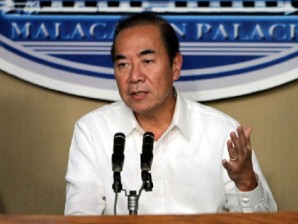MANILA, Philippines – Public Works and Highways Secretary Rogelio Singson ordered the director of the DPWH in Metro Manila to finish ongoing road works in the metropolis ASAP.
Singson’s order is contained in a text message to Reynaldo Tagudando, director for the National Capital Region of the Department of Public Works and Highways.
Singson was apparently angry over the monthslong delay in the completion of a project involving a 300-meter portion of the North Extension of Circumferential Road 5, or C-5, in Quezon City.
“Secretary Singson is asking me for a timetable for the completion of the project,” Tagudando told the Philippine Daily Inquirer in Filipino. “He’s already angry because the project is delayed.”
Make that “really much delayed,” Tagudando acknowledged in his interview with the Inquirer.
“Our target was last June, before the opening of classes. Unfortunately, that portion onward Luzon Avenue has yet to be completed. That is why, it wasn’t included in our soft opening last April. Work there stopped early this year,” Tagudando said.
The DPWH, he said, “has received many complaints” from motorists using C-5.
“They say they’re legitimate taxpayers so they do not deserve to suffer from traffic congestion in that major thoroughfare that’s supposedly built to decongest traffic in Metro Manila,” Tagudando said.
But he said the DPWH was “definitely not to blame” for the delay.
“The truth is, we could complete it in only 45 days. But we’re facing right-of-way problems. Houses belonging to 80-plus illegal-settler families are blocking the actual road project, which is government property. And they are not your ordinary type of squatter families. I’m talking about people with jobs, as well as operators of small businesses like ‘sari-sari’ stores and eateries, among others,” Tagudando said.
The DPWH, however, has convinced at least 50 of the families to leave the area, he said.
The department offers P60,000 to P100,000 per family to move elsewhere, he said.
“Actually, we have already paid about 20 families,” he said. “Our right-of-way people had a hard time talking to them, but they succeeded. Quezon City Hall and barangay officials are helping us convince the remaining 30-plus families to cooperate and let us finish the project,” he said.
Tagudando said he had written to the illegal settlers, appealing to them to leave as soon as possible because the government needed the property.
“After all, they’ve lived there for a long time and free at that … It’s time for them to show their sense of responsibility as good citizens and love of country,” Tagudando said.
He said he was confident the department would be able to resume work on the project “by end-September.”
“We’ll start the demolition of the squatter homes, and as I’ve said earlier, complete the project in 45 days,” he said.
The North Extension of C-5 stretches from Katipunan Avenue to Tandang Sora Avenue, crossing Commonwealth Avenue through a flyover that ends at Luzon Avenue.
Residents of Barangay Old Balara, Culiat and Pasong Tamo oppose the project because they do not want to leave the place. They say they do not want to lose their homes and they do not have enough money to relocate.
The government “has no plans to relocate the illegal settlers. We’re giving them cash payments, depending on the sizes of their houses,” Tagudando said.
In her State of the Nation Address in 2007, President Gloria Macapagal-Arroyo cited the C-5 extension as one of the priority road projects of her administration.
She announced that the project would extend from Katipunan Avenue in Quezon City to Navotas City while the South Extension would be from the South Luzon Expressway in Parañaque City to the Coastal Road in Las Piñas.
Begun in April 2008, the project was supposed to be completed by August 2009.
Before the 2010 presidential election, the C-5 South Extension project got tangled in a controversy involving Sen. Manuel Villar Jr., who had his eye on the presidency. His critics charged that Villar inserted P200 million into the DPWH budget for the project, which would increase the value of his real-estate properties through which the road extension would cut. The DPWH budget for the project was P200 million and Villar’s alleged insertion would have doubled it.
Villar, a real-estate developer, denied any wrongdoing, saying he did not and would not get anything from the additional funding.
Senate President Juan Ponce Enrile confirmed Villar’s request for P200 million, which he said was not irregular and was intended to ensure speedy completion of the project.
But then Senator Jamby Madrigal brought an ethics complaint against Villar. Villar’s allies went to the Supreme Court, asking that the complaint be transferred to the Senate committee on the whole.
The Supreme Court granted the petition in March last year, but the investigation was sidelined by more pressing legislative business.
The original C-5, 19.7 kilometers long, stretches from Parañaque to the North Luzon Expressway in Valenzuela City. It runs through the eastern portion of Metro Manila, effectively serving as a reliever road for Circumferential Road 4, better known as the Epifanio de los Santos Avenue, or Edsa.
The major arteries of C-5 are Tandang Sora Avenue, Congressional Avenue, Luzon Avenue, Katipunan Avenue, Col. Boni Serrano Avenue, Eulogio Rodriguez Jr. Avenue, Carlos P. Garcia Avenue and the Moonwalk Access Road.
It was conceptualized sometime in the late 1950s, when the then Highway 54 (now Edsa) was the main beltway connecting Caloocan City, Quezon City, Pasig, Mandaluyong and Makati. (With a report from Inquirer Research)
